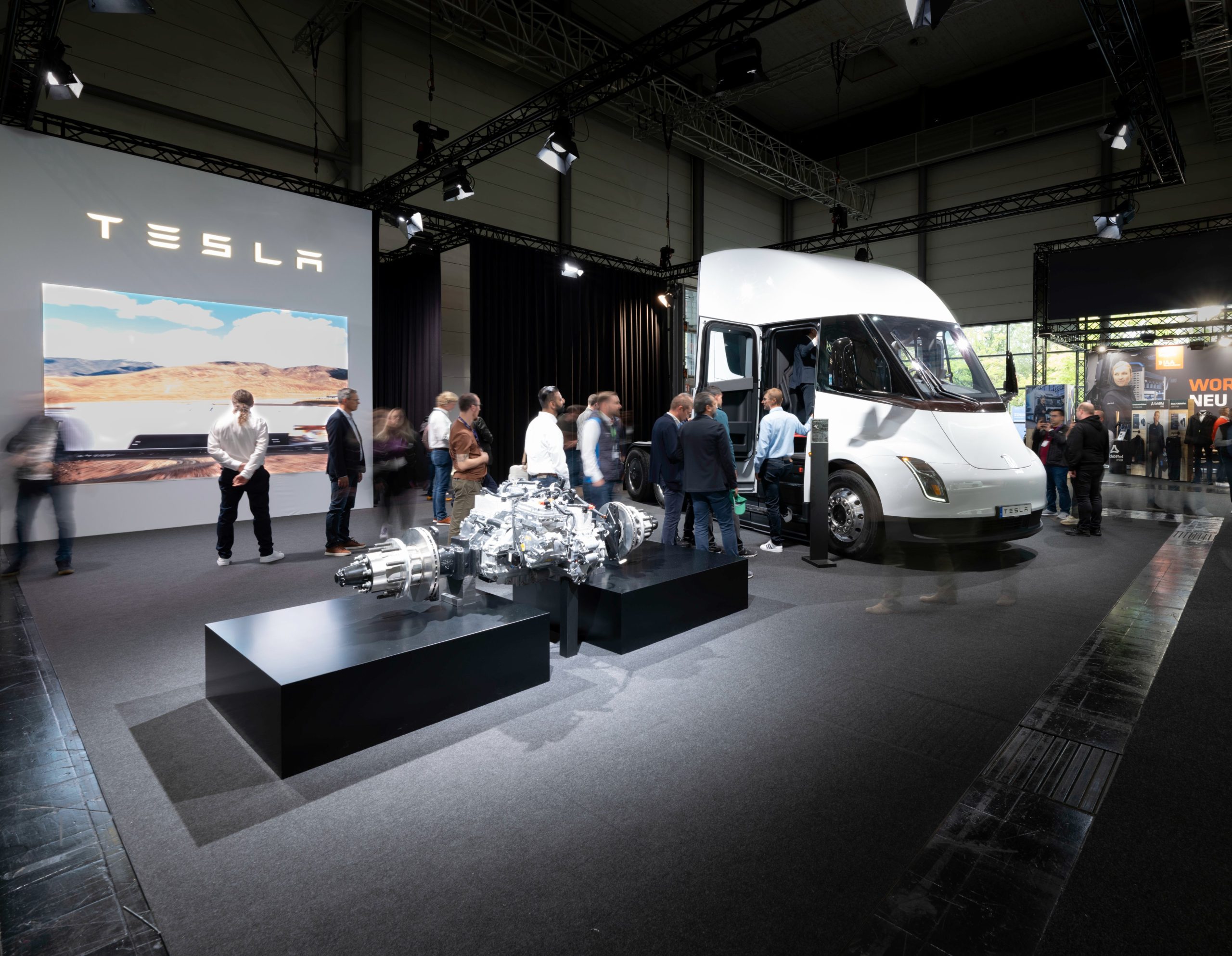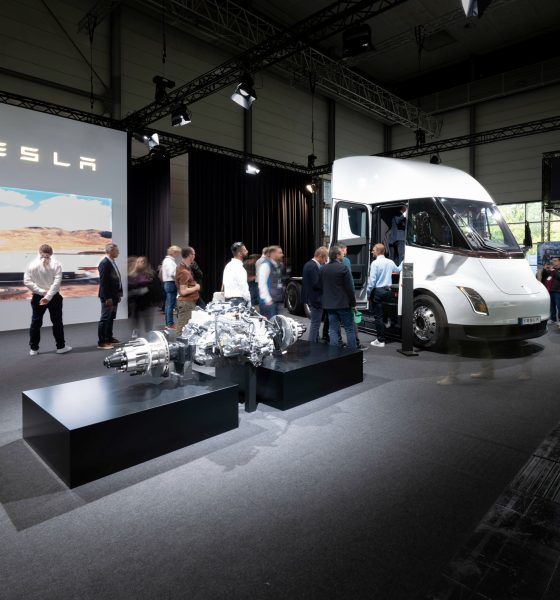

News
Tesla Semi sleeper section and large side storage teased in new video
Recent videos of the Tesla Semi at the 2024 IAA Transportation trade show in Hannover, Germany have revealed some new details about the production version of the Class 8 all-electric truck. These include, among other things, a space for a sleeper area and some clever storage space on the sides of the vehicle.
The Tesla Semi was initially unveiled in late 2017, though deliveries of the vehicle to its first customer, PepsiCo, started in December 2022. A number of changes have been rolled out to the Semi’s design since its unveiling, from the changing of its door handles to the removal of its frunk.
I learned a few new things checking out the very first Tesla Semi in Europe today.
A thread ?:
1. Tesla has already designed the Semi with sleeper cab in mind per the team, they're "keeping the space" for it with a metal frame in place: pic.twitter.com/I5qLLn3Dtr— Jaan of the EV Universe ⚡ (@TheEVuniverse) September 16, 2024
Electric vehicle enthusiast @TheEVuniverse recently shared some videos featuring the Tesla Semi at the electric vehicle maker’s booth in the IAA Transportation 2024 exhibitor’s hall. The EV advocate noted that he was fortunate enough to capture some footage of the Tesla Semi at the event, and he was also able to learn a number of interesting details about the vehicle.
2. The Tesla Semi has been designed 'international' from start, so they had to change very little for Europe entry (only minor details like wheel covers etc).
Semi hasn't gone through homologation for EU markets, as it isn't launching just yet (as far as I could understand) pic.twitter.com/cmz18ApPAF— Jaan of the EV Universe ⚡ (@TheEVuniverse) September 16, 2024
These include a sleeper cab, which would be useful for Tesla Semi units that would be deployed for long routes. Tesla has reportedly designed the Semi with a sleeper cab in mind, so for now, the area where the sleeper cab would be built is occupied by a metal frame. Considering the area occupied by a metal frame in the EV advocate’s video, it would appear that the Semi’s sleeper area would be quite spacious.
3. The Tesla Semi storage compartments on both sides are actually rather large, and they pop wide open when pushing a button on the touchscreen.
The Semi doesn't have a frunk, although they didn't show us under the hood because of the competition snooping pic.twitter.com/IhdmUFUoIa— Jaan of the EV Universe ⚡ (@TheEVuniverse) September 16, 2024
The production Tesla Semi is also fitted with side storage compartments, which are located on both sides of the Class 8 all-electric truck. The storage spaces are rather large, and they are reportedly opened through a button on the Tesla Semi’s touchscreen. Interestingly enough, the door of the vehicle also features physical buttons that open the hood and side storage areas.
4. The Tesla Semi door has buttons to open the hood and the side storage door;
The window doesn't seem to open too much, but enough for toll booth payments etc;
The red loop with the dude is a handle that opens the door in case of emergency:
The cabin is surprisingly spacious pic.twitter.com/lfbYREUqpN— Jaan of the EV Universe ⚡ (@TheEVuniverse) September 16, 2024
The Tesla Semi features a central driving position, which suggests that the vehicle was designed for international markets from the beginning. Tesla reportedly only has to change very little in the Semi for it to be approved for Europe. The vehicle has not gone through homologation in EU markets yet, though this would likely be done later as the vehicle prepares to enter the region.
Don’t hesitate to contact us with news tips. Just send a message to simon@teslarati.com to give us a heads up.

News
Tesla starts showing how FSD will change lives in Europe
Local officials tested the system on narrow country roads and were impressed by FSD’s smooth, human-like driving, with some calling the service a game-changer for everyday life in areas that are far from urban centers.

Tesla has launched Europe’s first public shuttle service using Full Self-Driving (Supervised) in the rural Eifelkreis Bitburg-Prüm region of Germany, demonstrating how the technology can restore independence and mobility for people who struggle with limited transport options.
Local officials tested the system on narrow country roads and were impressed by FSD’s smooth, human-like driving, with some calling the service a game-changer for everyday life in areas that are far from urban centers.
Officials see real impact on rural residents
Arzfeld Mayor Johannes Kuhl and District Administrator Andreas Kruppert personally tested the Tesla shuttle service. This allowed them to see just how well FSD navigated winding lanes and rural roads confidently. Kruppert said, “Autonomous driving sounds like science fiction to many, but we simply see here that it works totally well in rural regions too.” Kuhl, for his part, also noted that FSD “feels like a very experienced driver.”
The pilot complements the area’s “Citizen Bus” program, which provides on-demand rides for elderly residents who can no longer drive themselves. Tesla Europe shared a video of a demonstration of the service, highlighting how FSD gives people their freedom back, even in places where public transport is not as prevalent.
What the Ministry for Economic Affairs and Transport says
Rhineland-Palatinate’s Minister Daniela Schmitt supported the project, praising the collaboration that made this “first of its kind in Europe” possible. As per the ministry, the rural rollout for the service shows FSD’s potential beyond major cities, and it delivers tangible benefits like grocery runs, doctor visits, and social connections for isolated residents.
“Reliable and flexible mobility is especially vital in rural areas. With the launch of a shuttle service using self-driving vehicles (FSD supervised) by Tesla in the Eifelkreis Bitburg-Prüm, an innovative pilot project is now getting underway that complements local community bus services. It is the first project of its kind in Europe.
“The result is a real gain for rural mobility: greater accessibility, more flexibility and tangible benefits for everyday life. A strong signal for innovation, cooperation and future-oriented mobility beyond urban centers,” the ministry wrote in a LinkedIn post.
News
Tesla China quietly posts Robotaxi-related job listing
Tesla China is currently seeking a Low Voltage Electrical Engineer to work on circuit board design for the company’s autonomous vehicles.

Tesla has posted a new job listing in Shanghai explicitly tied to its Robotaxi program, fueling speculation that the company is preparing to launch its dedicated autonomous ride-hailing service in China.
As noted in the listing, Tesla China is currently seeking a Low Voltage Electrical Engineer to work on circuit board design for the company’s autonomous vehicles.
Robotaxi-specific role
The listing, which was shared on social media platform X by industry watcher @tslaming, suggested that Tesla China is looking to fill the role urgently. The job listing itself specifically mentions that the person hired for the role will be working on the Low Voltage Hardware team, which would design the circuit boards that would serve as the nervous system of the Robotaxi.
Key tasks for the role, as indicated in the job listing, include collaboration with PCB layout, firmware, mechanical, program management, and validation teams, among other responsibilities. The role is based in Shanghai.
China Robotaxi launch
China represents a massive potential market for robotaxis, with its dense urban centers and supportive policies in select cities. Tesla has limited permission to roll out FSD in the country, though despite this, its vehicles have been hailed as among the best in the market when it comes to autonomous features. So far, at least, it appears that China supports Tesla’s FSD and Robotaxi rollout.
This was hinted at in November, when Tesla brought the Cybercab to the 8th China International Import Expo (CIIE) in Shanghai, marking the first time that the autonomous two-seater was brought to the Asia-Pacific region. The vehicle, despite not having a release date in China, received a significant amount of interest among the event’s attendees.
Elon Musk
Elon Musk and Tesla AI Director share insights after empty driver seat Robotaxi rides
The executives’ unoccupied tests hint at the rapid progress of Tesla’s unsupervised Robotaxi efforts.

Tesla CEO Elon Musk and AI Director Ashok Elluswamy celebrated Christmas Eve by sharing personal experiences with Robotaxi vehicles that had no safety monitor or occupant in the driver’s seat. Musk described the system’s “perfect driving” around Austin, while Elluswamy posted video from the back seat, calling it “an amazing experience.”
The executives’ unoccupied tests hint at the rapid progress of Tesla’s unsupervised Robotaxi efforts.
Elon and Ashok’s firsthand Robotaxi insights
Prior to Musk and the Tesla AI Director’s posts, sightings of unmanned Teslas navigating public roads were widely shared on social media. One such vehicle was spotted in Austin, Texas, which Elon Musk acknowleged by stating that “Testing is underway with no occupants in the car.”
Based on his Christmas Eve post, Musk seemed to have tested an unmanned Tesla himself. “A Tesla with no safety monitor in the car and me sitting in the passenger seat took me all around Austin on Sunday with perfect driving,” Musk wrote in his post.
Elluswamy responded with a 2-minute video showing himself in the rear of an unmanned Tesla. The video featured the vehicle’s empty front seats, as well as its smooth handling through real-world traffic. He captioned his video with the words, “It’s an amazing experience!”
Towards Unsupervised operations
During an xAI Hackathon earlier this month, Elon Musk mentioned that Tesla owed be removing Safety Monitors from its Robotaxis in Austin in just three weeks. “Unsupervised is pretty much solved at this point. So there will be Tesla Robotaxis operating in Austin with no one in them. Not even anyone in the passenger seat in about three weeks,” he said. Musk echoed similar estimates at the 2025 Annual Shareholder Meeting and the Q3 2025 earnings call.
Considering the insights that were posted Musk and Elluswamy, it does appear that Tesla is working hard towards operating its Robotaxis with no safety monitors. This is quite impressive considering that the service was launched just earlier this year.








